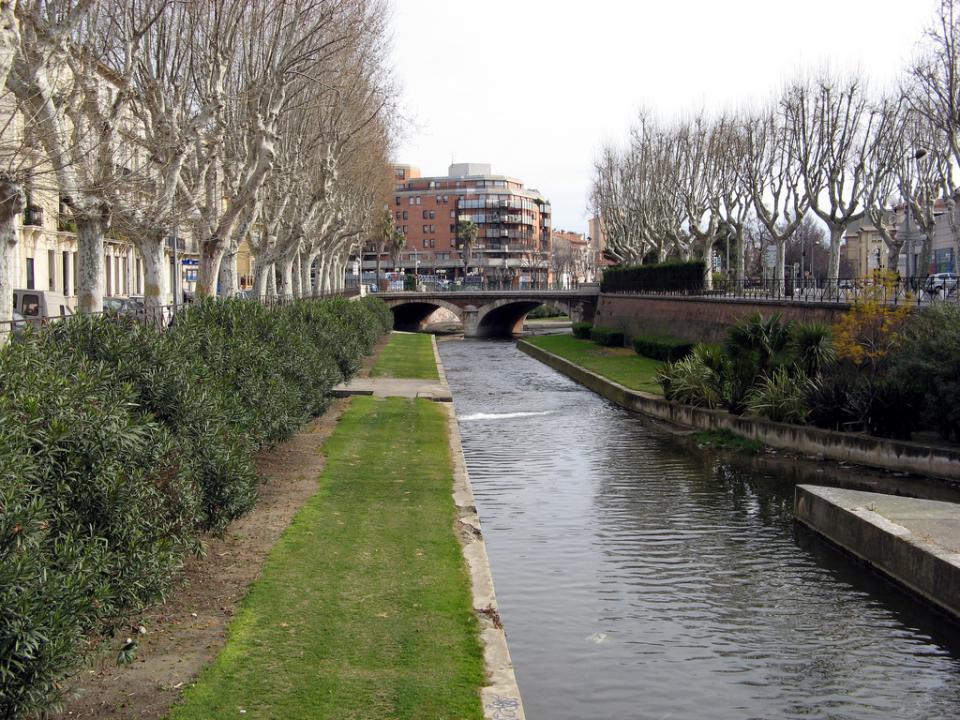
Têt canal in today’s Perpignan
Têt canal in today’s Perpignan
2008 Ian Copley
Click here to view Flickr source.
 This work is licensed under a Creative Commons Attribution-NonCommercial-ShareAlike 3.0 Unported License.
This work is licensed under a Creative Commons Attribution-NonCommercial-ShareAlike 3.0 Unported License.
After a generation of unprecedented floods, fourteenth-century princes of Roussillon, a then autonomous county of the royal house of Aragon, advanced a remarkably far-seeing program of river basin management. Both the policy and its failure exemplify the growing environmental awareness, ambitions, and weaknesses of emergent European state structures.
Local watercourses of the eastern Pyrenees, notably the principal rivers Tech, Têt, and Agly, had been stable for millennia. Roman and twelfth-century buildings on the flood plain shared the same elevation. Then came disastrous floods in 1264, 1307, 1316, 1322, 1332, 1419, 1421, and more after 1530, to name only the best-documented events. People abandoned riverside settlements now buried under two to four meters of fourteenth-century alluvium. In retrospect, clearance of foothills for fuel, abandonment of arable, and the stormy onset of the cooler, wetter “Little Ice Age” climate together shaped a new and dangerous hydraulic regime.
Local communities responded first. The city of Perpignan taxed riparian landowners in 1327 and the 1330s to build protective dikes and weirs and plant trees to reinforce river banks. But some villages and landholders complained that the enlarged riverbed diminished their properties.
Confronted with failure of site-specific measures and appealing to “the common good,” King-Count Peter IV enlarged the management program. In 1362 he ordered a study of diverting the beds of Têt and Agly to preserve good land near Perpignan. In 1378 royal officials gained agreement to realign three to four kilometers of the Têt from the town to its confluence with the Agly and to protect the new channel with tree plantings. In 1382-83 the prince extended the project to the lower Agly and the Tech. Entrusted to local commissioners from Perpignan, the proposal aroused opposition. The Bishop of Elne, other landowners, and village communities on the lower Tech claimed their losses would exceed anticipated gains. Resistance and rising costs doomed the effort. In 1399 Martin I lamented failure of his father’s scheme and resulting continual losses of land and production. After the flood of 1419, Perpignan could again take only local measures.
This incident shows that state responses to environmental hazards, even the recognition of some human responsibility, do go back to the Middle Ages. So does local resistance, whether from myopic economic interests or opposition to an often narrow concentration of state thinking on a single purpose—in this case, rivers as conduits of excess water.
How to cite
Hoffmann, Richard. “Bold State Effort Fails to Control Floods in Fourteenth-century Roussillon.” Environment & Society Portal, Arcadia (2012), no. 16. Rachel Carson Center for Environment and Society. https://doi.org/10.5282/rcc/3925.
ISSN 2199-3408
Environment & Society Portal, Arcadia
 This work is licensed under a Creative Commons Attribution-NonCommercial-ShareAlike 3.0 Unported License.
This work is licensed under a Creative Commons Attribution-NonCommercial-ShareAlike 3.0 Unported License.
2012 Richard Hoffmann
This refers only to the text and does not include any image rights.
Please click on the images to view their individual rights status.
- Calvet, Marc, et al. “Les cours d’eau des Pyrénées orientales depuis 15 000 ans. État des connaissances et perspectives de recherche.” In Les fleuves ont une histoire. Paléo environnement des rivières et des lacs français depuis 15 000 ans, edited by Jean Paul Bravard, and Michel Magny, 279 294. Paris: Errance, 2002.
- Caucanas, S. “Les tentatives de régularisation des cours d”eau en Roussillon au XIVe siècle.” In L’aiguat de 40; les inondations catastrophiques et les politiques de prévention en Méditerranée nord occidentale, Actes du colloque de Vernet les Bains" les inondations d'octobre 1940 en Catalogne; 50 ans passés", 18 20 octobre 1990, 383 388. Centre de Recherche et d'Etudes Catalanes de l'Université de Perpignan, Centre de géographie physique Henri Elhaï de l'Université Paris X Nanterre, Generalitat de Catalunya. Barcelona: Generalitat de Catalunya, 1993.
- Scott, James C. Seeing Like a State: How Certain Schemes to Improve the Human Condition Have Failed. New Haven: Yale University Press, 1998.
- Tréton, Rodrique. “Crues et inondations dans les Pyrénées méditerranéennes aux XIVe et XVe siècles: état des sources et perspectives recherché.” In “Activités, échanges et peuplement entre antiquité et moyen âge en Pyrénées orientales et Aude,” edited by Aymat Catafau, 212–224. Special issue, Domitia: revue du Centre de Recherches Historiques sur les Sociétés Méditerranéennes 8–9 (March 2007).
- Zadora Rio, Elisabeth. “Aménagements hydrauliques et inférences socio politiques: Études de cas au moyen âge,” In Fleuves et marais, une histoire au croisement de la nature et de la culture. Sociétés préindustrielles et milieux fluviaux, lacustres et palustres: pratiques sociales et hydrosystèmes, edited by Joëlle Burnouf and Phillipe Leveau, 387 393. Paris: CTHS, 2004.








